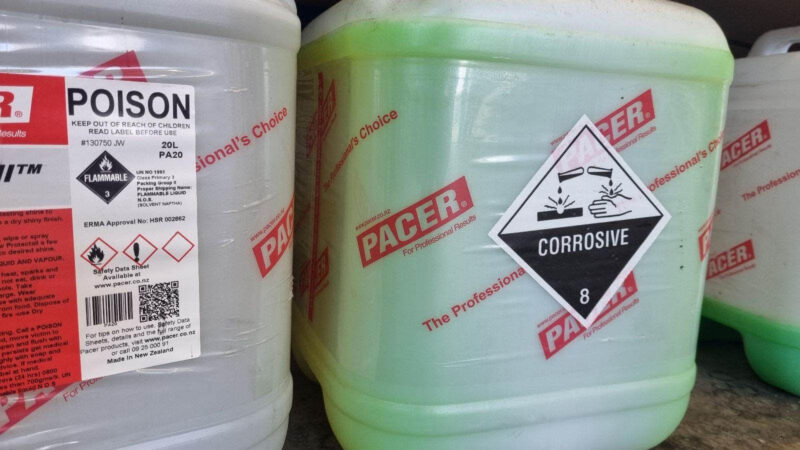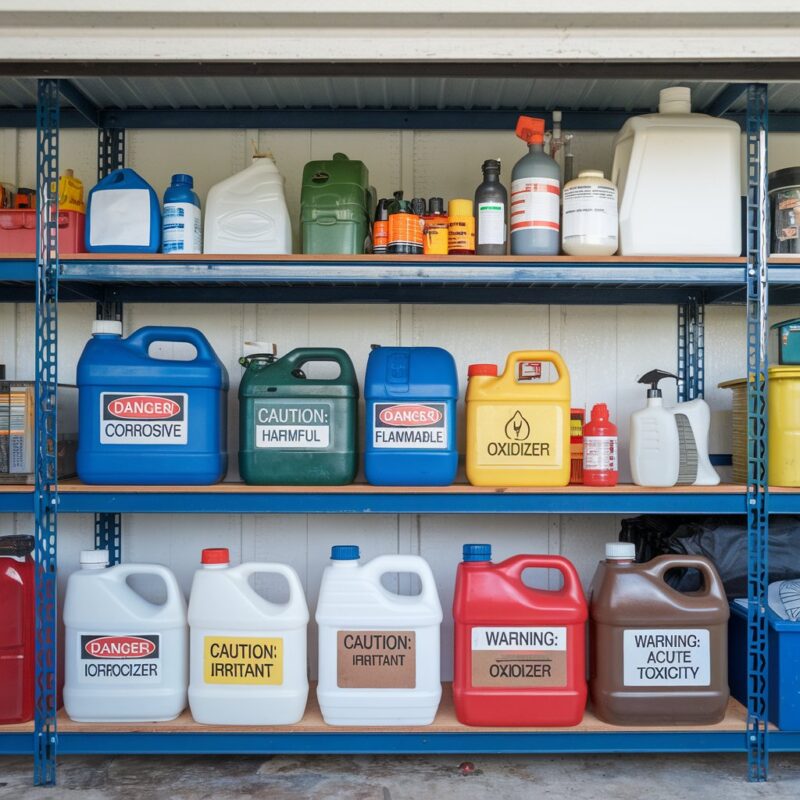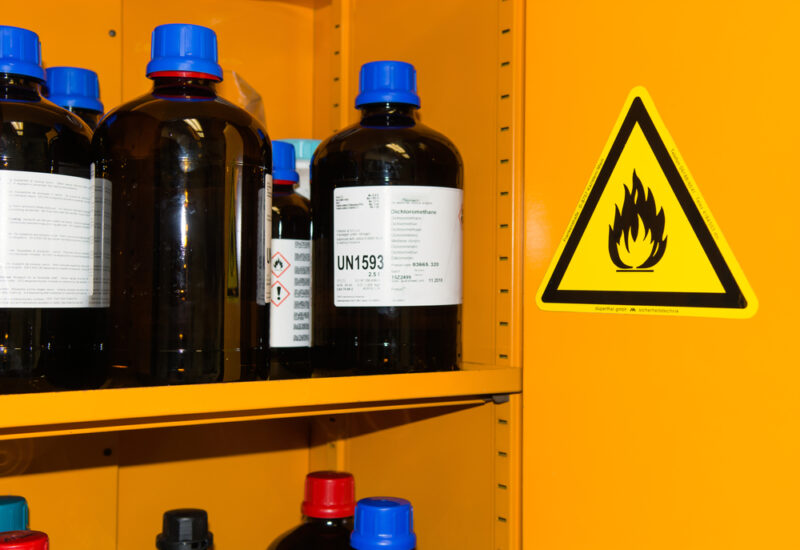As homeowners, we often overlook the potential dangers lurking in our cabinets, garages, and sheds. The multitude of chemicals we use for cleaning, maintenance, and hobbies can pose significant risks if not stored properly. One of the most underestimated hazards is the potential for dangerous reactions when incompatible chemicals are kept in close proximity. If the packaging is good, then the danger is minimal, but if there’s a leak, there’s the potential for toxic fumes, fires and even explosions. So, how important is proper chemical storage, what happens if you take common household products that shouldn’t mix and store them with each other, and what are safe storage practices?
Decoding Chemical Classifications: Dangerous Goods Classes

Chemicals are categorized based on their properties and potential hazards so that you can quickly look at a hazard placard and understand the potential risks. A hazard placard is a diamond-shaped sign or label that’s given a number from 1-9; 1 is explosives and 9 includes miscellaneous dangerous goods. Some classifications you might encounter in your house include:
- Flammable gases (Class 2.1)
- Flammable liquids (Class 3)
- Substances liable to spontaneous combustion (Class 4.2)
- Oxidizing substances (Class 5.1)
- Toxic substances (Class 6.1)
- Corrosive substances (Class 8)
These classifications serve as a guide for determining which chemicals can be safely stored together and which need separation (also called segregation).
If you are transporting these dangerous goods in a vehicle, then there are limits for the quantity and limitations for the intent of use. If they are for your own use and in low quantities, then no permits are usually required. However, if you are transporting them for hire or reward, or in larger quantities, you may need to have taken a D endorsement course or have done dangerous goods handler training.
Everyday Items That Don’t Play Nice Together

Let’s explore some common household products that fall into these categories and should be kept apart:
- Vinegar and bleach: Vinegar is acidic (Class 8), while bleach is an oxidizer (Class 5.1). Mixing these can produce toxic chlorine gas. Keep these common cleaning agents well separated.
- Rubbing alcohol and bleach: Rubbing alcohol is flammable (Class 3), and bleach is an oxidizer (Class 5.1). Their combination can create chloroform, a toxic compound.
- WD-40 and chlorine-based cleaners: WD-40 is flammable (Class 3), while chlorine-based cleaners are often oxidizers (Class 5.1). This combination can be potentially explosive. Store these garage and household items separately.
- Hydrogen peroxide and vinegar: Hydrogen peroxide is an oxidizer (Class 5.1), sometimes used in pool maintenance, and vinegar is acidic (Class 8). Mixing these creates peracetic acid, which can be corrosive and irritating. Keep these common household chemicals apart.
- Wood stain and oxidizers: Oil-based wood stain (Class 3 – Flammable liquid) and hydrogen peroxide (Class 5.1 – Oxidizer) This combination increases the risk of spontaneous combustion.
- Rust removers and bleach: Oxalic acid-based rust remover and chlorine bleach can create toxic fumes and a potentially explosive reaction.
- Lime and pool chlorine: Calcium oxide (lime) and calcium hypochlorite (pool chlorine) This combination can generate heat and potentially cause a fire.
Bulk Storage Concerns
Some chemicals are often stored in larger quantities at home, especially in garages or garden sheds. These may include:
- Propane/LPG tanks for grills
- Kerosene for heaters
- Wood stain and varnish
- Lawn and garden chemicals
- Automotive fluids (transmission fluid, power steering fluid)
- De-icing salt
- Pool chemicals
Storing these items in larger amounts increases potential risks if incompatible chemicals are placed too close together. For instance:
- Propane tanks (Class 2.1) should be stored outdoors with plenty of ventilation, away from other flammable materials and oxidizers.
- Kerosene (Class 3) should be kept separate from oxidizing substances like some lawn chemicals or de-icing salts.
- Wood stains and varnishes (often Class 3) should be isolated from any oxidizers or corrosive substances.
Building a Shed or Storage for Chemicals at your House
If you will need to store chemicals in any quantity, then you can consider a separate shed to keep those segregated, or purchase a segregation device, which is a metal cabinet that complies with fire safety rules.
If you’re storing large quantities of fuel (e.g. you run a business where you might want to store more than 500 litres of petrol or diesel), then you absolutely should contact your local fire department or council for the rules. You may need to install the tank where any spillage can be captured without entering groundwater systems.
Best Practices for Safe Chemical Storage

To minimize risks associated with chemical storage, consider these guidelines:
- Scrutinize labels: Product labels often provide storage instructions and incompatibility warnings.
- Maintain original packaging: Keep chemicals in their original containers whenever possible. If transfer is necessary, use a container designed for that specific type of chemical.
- Create a segregation system: Use the compatibility chart information to establish separate storage zones for different chemical classes. For example:
- Store flammable gases (Class 2.1) outdoors in a well-ventilated area.
- Keep substances liable to spontaneous combustion (Class 4.2) in a cool, dry place away from other materials.
- Store corrosive substances (Class 8) in a leak-proof cabinet, isolated from other chemicals.
- Ensure proper airflow: Make sure your storage areas, particularly for flammable and toxic substances, have adequate ventilation to prevent fume accumulation.
- Implement spill containment: For liquid chemicals, use trays or bins to catch potential leaks and prevent incompatible substances from mixing if spills occur.
- Conduct regular checks: Frequently inspect your chemical storage areas for signs of leaks, corrosion, or compromised containers, and ensure the tops are on properly. Properly dispose of any expired or deteriorating products.
- Practice elevated storage: Keep all potentially hazardous chemicals out of reach of children and pets, preferably in locked cabinets or on high shelves.
- Control environmental factors: Maintain storage areas at moderate temperatures and low humidity. Extreme conditions can cause some chemicals to become unstable or reactive.
Limitations and Special Considerations
While proper storage is essential, it’s important to recognize certain limitations and considerations for home chemical storage:
- Legal restrictions: Some areas have regulations limiting the quantities of certain chemicals that can be stored in residential settings. Organisations to talk to are your local fire department, council or housing authority for specific guidelines. For example, some chemicals may only be stored in quantities of 50, 100 or 200 litres before other safety measures need to be put in place.
- Alternative storage options: For large quantities or particularly hazardous materials, consider professional storage facilities or more frequent disposal rather than long-term home storage.
- Eco-friendly disposal: Proper disposal of household chemicals can be difficult. Many cannot be discarded in regular trash, poured down drains or poured on a lawn. Research local hazardous waste disposal options in your community.
- Natural disaster preparedness: If you live in an area prone to natural disasters like floods, earthquakes, or wildfires, take extra precautions in your chemical storage to prevent accidental mixing or release during such events.
In conclusion, the safe storage of household chemicals is a critical yet often neglected aspect of home safety. By understanding the potential risks of incompatible chemical storage and implementing proper segregation and storage practices, you can significantly reduce the risk of accidents, fires, or harmful chemical reactions in your home. When in doubt about the compatibility or safe storage of a particular product, always consult the Safety Data Sheet (SDS) or reach out to the manufacturer for specific guidance.


